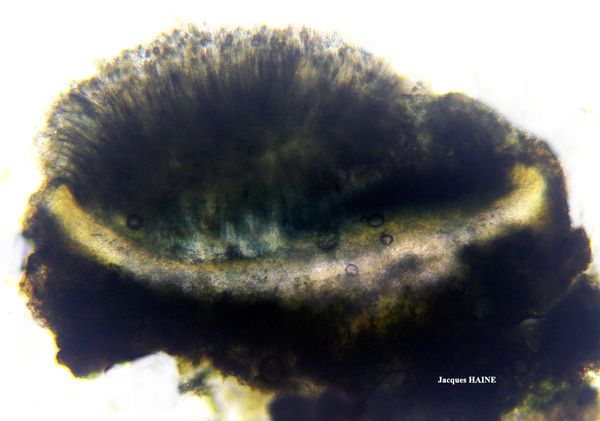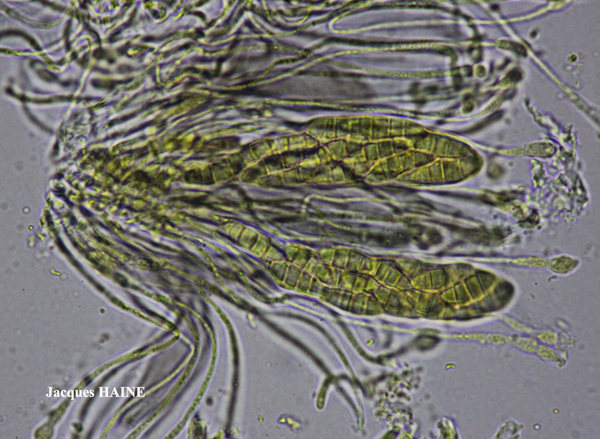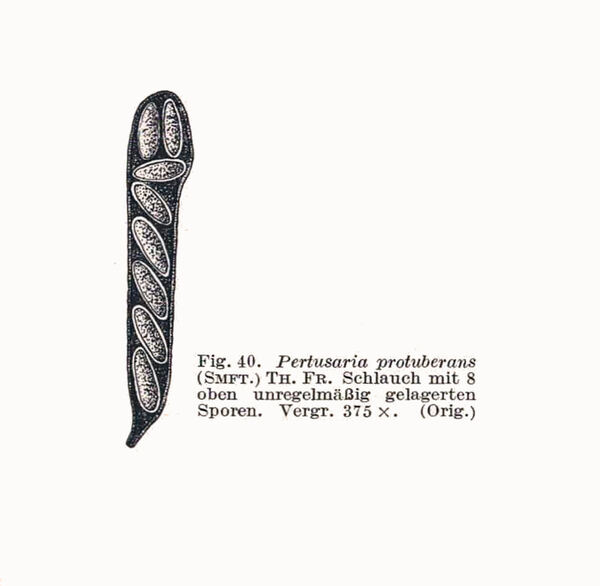Gyalecta carneolutea (Turner) H. Olivier
Flore de l'Orne, 2: 187, 1884. Basionym: Parmelia carneolutea Turner - Trans. Linn. Soc. London, 9: 145, 1808.
Synonyms: Cryptolechia carneolutea (Turner) A. Massal.; Gyalectina carneolutea (Turner) Vězda; Pachyphiale carneolutea (Turner) Samp.
Distribution: N - Lomb. C - Tosc.
Description: Thallus crustose, thinly episubstratic, smooth and continuous to finely cracked, white to pale grey. Apothecia 0.4-1 mm across, at first slightly immersed and urceolate, then subsessile, with a yellow-orange to ochraceous pink, finally sometimes reddish brown, concave to flat disc, and a whitish, slightly prominent, often crenulate, more or less persistent proper margin. Proper exciple thin, colourless: epithecium pale yellowish brown; hymenium colourless; paraphyses mostly simple, 1.5-2 µm thick at mid-level, with swollen, up to 4 µm wide apical cells; hypothecium colourless. Asci (8-)12(-16) spored, narrowly clavate, with a single, I+ blue functional wall layer, the apex not thickened and without an internal apparatus. Ascospores 3(-4)-septate, hyaline, oblong-ellipsoid, 10-23 x 3-5 µm. Pycnidia inconspicuous, immersed in thalline warts. Conidia exobasidiate, of two types: microconidia borne on a stalk, and sessile, ellipsoid, 4-6 µm long macroconidia. Photobiont trentepohlioid. Spot tests: K-, C-, KC-, P-, UV-. Chemistry: without lichen substances.Note: a mild-temperate species with subtropical affinities, found on nutrient-rich bark in very humid situations, only known from two old records and perhaps extinct, but to be looked for further in Tyrrhenian Italy. It is included as “Regionally Extinct” in the Italian red list of epiphytic lichens (Nascimbene & al. 2013c).
Growth form: Crustose
Substrata: bark
Photobiont: Trentepohlia
Reproductive strategy: mainly sexual
Restricted to humid-warm, oceanic areas
Commonnes-rarity: (info)
Alpine belt: absent
Subalpine belt: absent
Oromediterranean belt: absent
Montane belt: absent
Submediterranean belt: extremely rare
Padanian area: absent
Humid submediterranean belt: extremely rare
Humid mediterranean belt: extremely rare
Dry mediterranean belt: absent

Predictive model

Bernard Bouffinier - Source: http://www.lichensmaritimes.org/index.php?task=fiche&lichen=1056&lang=en
France, Crozon

Bernard Bouffinier - Source: http://www.lichensmaritimes.org/index.php?task=fiche&lichen=1056&lang=en
France, Crozon

Bernard Bouffinier - Source: http://www.lichensmaritimes.org/index.php?task=fiche&lichen=1056&lang=en
France, Crozon

Bernard Bouffinier - Source: http://www.lichensmaritimes.org/index.php?task=fiche&lichen=1056&lang=en
France, Crozon

Bernard Bouffinier - Source: http://www.lichensmaritimes.org/index.php?task=fiche&lichen=1056&lang=en
France, Crozon

Bernard Bouffinier - Source: http://www.lichensmaritimes.org/index.php?task=fiche&lichen=1056&lang=en
France, Crozon

Bernard Bouffinier - Source: http://www.lichensmaritimes.org/index.php?task=fiche&lichen=1056&lang=en
France, Crozon

Bernard Bouffinier - Source: http://www.lichensmaritimes.org/index.php?task=fiche&lichen=1056&lang=en
France, Crozon

Bernard Bouffinier - Source: http://www.lichensmaritimes.org/index.php?task=fiche&lichen=1056&lang=en
France, Crozon

Michel David - Source: http://www.lichensmaritimes.org/index.php?task=fiche&lichen=1056&lang=en
France, Crozon

Michel David - Source: http://www.lichensmaritimes.org/index.php?task=fiche&lichen=1056&lang=en
France, Crozon

Jacques Haine - Source: http://www.lichensmaritimes.org/index.php?task=fiche&lichen=1056&lang=en
France, Crozon

Jacques Haine - Source: http://www.lichensmaritimes.org/index.php?task=fiche&lichen=1056&lang=en
France, Crozon

Jacques Haine - Source: http://www.lichensmaritimes.org/index.php?task=fiche&lichen=1056&lang=en
France, Crozon

Jacques Haine - Source: http://www.lichensmaritimes.org/index.php?task=fiche&lichen=1056&lang=en
France, Crozon

Jacques Haine - Source: http://www.lichensmaritimes.org/index.php?task=fiche&lichen=1056&lang=en
France, Crozon

Jacques Haine - Source: http://www.lichensmaritimes.org/index.php?task=fiche&lichen=1056&lang=en
France, Crozon

Jacques Haine - Source: http://www.lichensmaritimes.org/index.php?task=fiche&lichen=1056&lang=en
France, Crozon

Jacques Haine - Source: http://www.lichensmaritimes.org/index.php?task=fiche&lichen=1056&lang=en
France, Crozon
Growth form: Crustose
Substrata: bark
Photobiont: Trentepohlia
Reproductive strategy: mainly sexual
Restricted to humid-warm, oceanic areas
Commonnes-rarity: (info)
Alpine belt: absent
Subalpine belt: absent
Oromediterranean belt: absent
Montane belt: absent
Submediterranean belt: extremely rare
Padanian area: absent
Humid submediterranean belt: extremely rare
Humid mediterranean belt: extremely rare
Dry mediterranean belt: absent

Predictive model

Bernard Bouffinier - Source: http://www.lichensmaritimes.org/index.php?task=fiche&lichen=1056&lang=en
France, Crozon

Bernard Bouffinier - Source: http://www.lichensmaritimes.org/index.php?task=fiche&lichen=1056&lang=en
France, Crozon

Bernard Bouffinier - Source: http://www.lichensmaritimes.org/index.php?task=fiche&lichen=1056&lang=en
France, Crozon

Bernard Bouffinier - Source: http://www.lichensmaritimes.org/index.php?task=fiche&lichen=1056&lang=en
France, Crozon

Bernard Bouffinier - Source: http://www.lichensmaritimes.org/index.php?task=fiche&lichen=1056&lang=en
France, Crozon

Bernard Bouffinier - Source: http://www.lichensmaritimes.org/index.php?task=fiche&lichen=1056&lang=en
France, Crozon

Bernard Bouffinier - Source: http://www.lichensmaritimes.org/index.php?task=fiche&lichen=1056&lang=en
France, Crozon

Bernard Bouffinier - Source: http://www.lichensmaritimes.org/index.php?task=fiche&lichen=1056&lang=en
France, Crozon

Bernard Bouffinier - Source: http://www.lichensmaritimes.org/index.php?task=fiche&lichen=1056&lang=en
France, Crozon

Michel David - Source: http://www.lichensmaritimes.org/index.php?task=fiche&lichen=1056&lang=en
France, Crozon

Michel David - Source: http://www.lichensmaritimes.org/index.php?task=fiche&lichen=1056&lang=en
France, Crozon

Jacques Haine - Source: http://www.lichensmaritimes.org/index.php?task=fiche&lichen=1056&lang=en
France, Crozon

Jacques Haine - Source: http://www.lichensmaritimes.org/index.php?task=fiche&lichen=1056&lang=en
France, Crozon

Jacques Haine - Source: http://www.lichensmaritimes.org/index.php?task=fiche&lichen=1056&lang=en
France, Crozon

Jacques Haine - Source: http://www.lichensmaritimes.org/index.php?task=fiche&lichen=1056&lang=en
France, Crozon

Jacques Haine - Source: http://www.lichensmaritimes.org/index.php?task=fiche&lichen=1056&lang=en
France, Crozon

Jacques Haine - Source: http://www.lichensmaritimes.org/index.php?task=fiche&lichen=1056&lang=en
France, Crozon

Jacques Haine - Source: http://www.lichensmaritimes.org/index.php?task=fiche&lichen=1056&lang=en
France, Crozon

 Index Fungorum
Index Fungorum
 GBIF
GBIF



